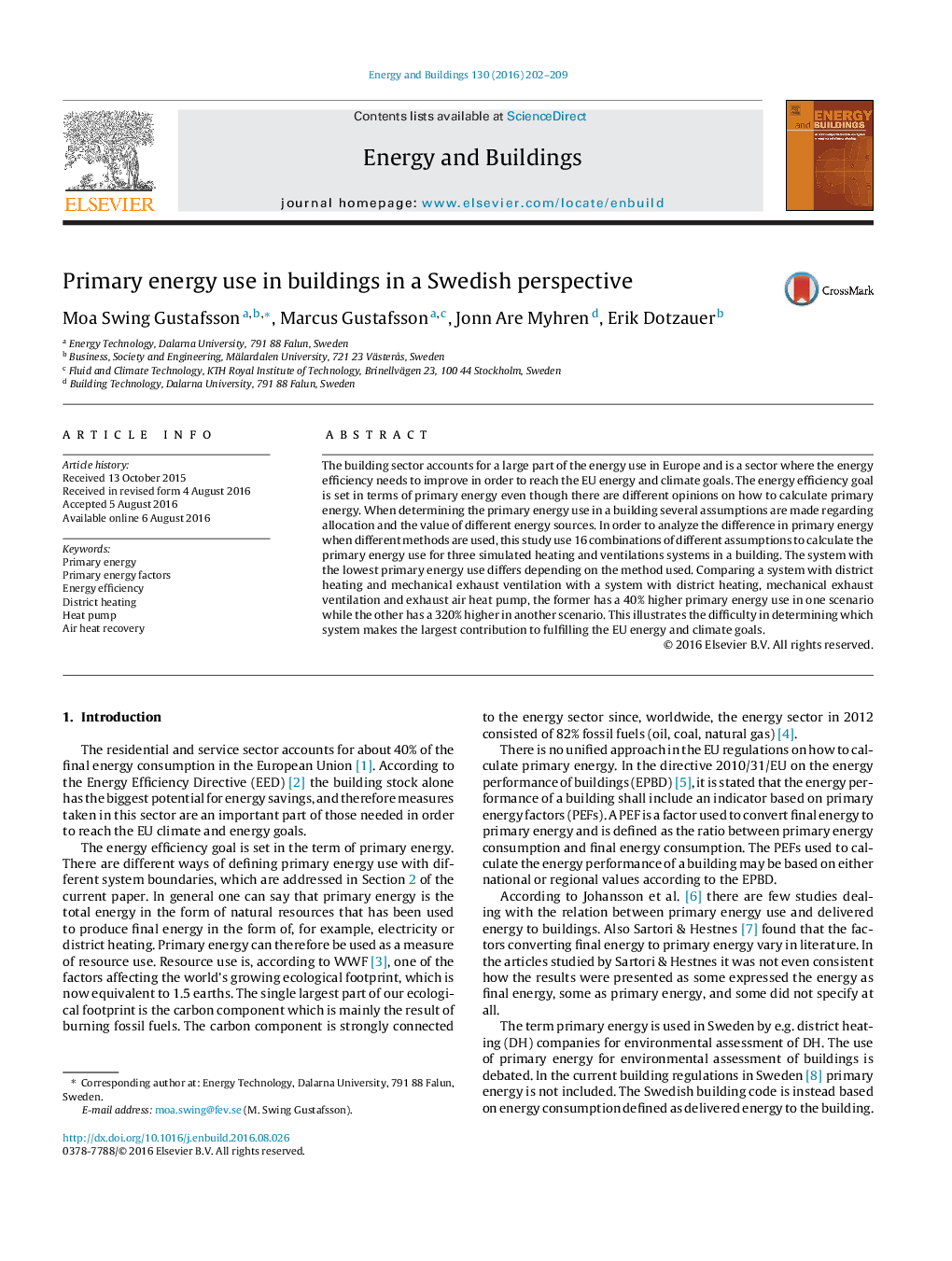| کد مقاله | کد نشریه | سال انتشار | مقاله انگلیسی | نسخه تمام متن |
|---|---|---|---|---|
| 4919587 | 1428960 | 2016 | 8 صفحه PDF | دانلود رایگان |
عنوان انگلیسی مقاله ISI
Primary energy use in buildings in a Swedish perspective
ترجمه فارسی عنوان
استفاده از انرژی اولیه در ساختمان ها در دیدگاه سوئدی
دانلود مقاله + سفارش ترجمه
دانلود مقاله ISI انگلیسی
رایگان برای ایرانیان
کلمات کلیدی
انرژی اولیه، فاکتورهای اولیه انرژی، بهره وری انرژی، گرمایش منطقه، پمپ حرارتی، بازیابی حرارت هوای،
ترجمه چکیده
بخش ساختمان بخش بزرگی از مصرف انرژی در اروپا را تشکیل می دهد و بخش ای است که در آن نیاز به بهبود بهره وری انرژی برای دستیابی به اهداف انرژی و آب و هوای اتحادیه اروپا وجود دارد. هدف کارآیی انرژی از لحاظ انرژی اولیه تنظیم می شود، گرچه عقاید مختلف در مورد نحوه محاسبه انرژی اولیه وجود دارد. هنگام تعیین مصرف انرژی اولیه در ساختمان چند فرضی در مورد تخصیص و ارزش منابع مختلف انرژی وجود دارد. به منظور تجزیه و تحلیل تفاوت انرژی اولیه در هنگام استفاده از روش های مختلف، این مطالعه از 16 ترکیب از مفروضات مختلف برای محاسبه مصرف انرژی اولیه برای سه سیستم گرمایش و تهویه شبیه سازی شده در یک ساختمان استفاده می کند. سیستم با کمترین استفاده از انرژی اولیه متفاوت است بسته به روش مورد استفاده. مقایسه سیستم با سیستم گرمایش مرکزی و تهویه مکانیکی مکانیکی با یک سیستم گرمایش مرکزی، تهویه مکانیکی تهویه و پمپ هوای خروجی، اولین مصرف انرژی اولیه 40 درصد در یک سناریو است، در حالی که دیگر در سناریوی دیگری 320 درصد بالاتر است . این نشان دهنده دشواری در تعیین اینکه چه سیستمی بیشترین سهم را در دستیابی به اهداف انرژی و آب و هوای اتحادیه اروپا دارد.
موضوعات مرتبط
مهندسی و علوم پایه
مهندسی انرژی
انرژی های تجدید پذیر، توسعه پایدار و محیط زیست
چکیده انگلیسی
The building sector accounts for a large part of the energy use in Europe and is a sector where the energy efficiency needs to improve in order to reach the EU energy and climate goals. The energy efficiency goal is set in terms of primary energy even though there are different opinions on how to calculate primary energy. When determining the primary energy use in a building several assumptions are made regarding allocation and the value of different energy sources. In order to analyze the difference in primary energy when different methods are used, this study use 16 combinations of different assumptions to calculate the primary energy use for three simulated heating and ventilations systems in a building. The system with the lowest primary energy use differs depending on the method used. Comparing a system with district heating and mechanical exhaust ventilation with a system with district heating, mechanical exhaust ventilation and exhaust air heat pump, the former has a 40% higher primary energy use in one scenario while the other has a 320% higher in another scenario. This illustrates the difficulty in determining which system makes the largest contribution to fulfilling the EU energy and climate goals.
ناشر
Database: Elsevier - ScienceDirect (ساینس دایرکت)
Journal: Energy and Buildings - Volume 130, 15 October 2016, Pages 202-209
Journal: Energy and Buildings - Volume 130, 15 October 2016, Pages 202-209
نویسندگان
Moa Swing Gustafsson, Marcus Gustafsson, Jonn Are Myhren, Erik Dotzauer,
